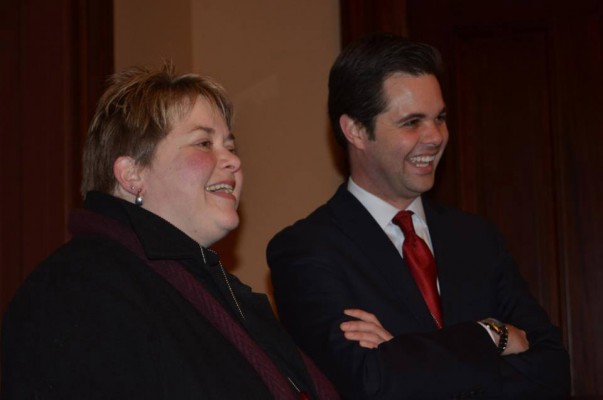Story by Katie Ericson
Photos courtesy of Noelle Smith
With registration coming up, everyone is looking at the class list for fall semester. Going through the courses, it is pretty clear that we have some inventive faculty members. From “Science and the Art of Da Vinci” to the “Spirit of Mathematics” to “Moral Monsters,” there are a lot of choices for Drake University students. But how do professors develop these courses?
 “Once you determine that your schedule allows you to develop a new class, and that department, college and university programs would benefit from that new course, you then submit proposals to the appropriate administrative review committees,” said Associate Professor of Politics and International Relations Rachel Paine Caufield.
“Once you determine that your schedule allows you to develop a new class, and that department, college and university programs would benefit from that new course, you then submit proposals to the appropriate administrative review committees,” said Associate Professor of Politics and International Relations Rachel Paine Caufield.
 Drake has a standard form for creating a new course, but what discipline you are creating the class for changes the process. For more standard courses, the process is not too difficult since those are only listed in one field.
Drake has a standard form for creating a new course, but what discipline you are creating the class for changes the process. For more standard courses, the process is not too difficult since those are only listed in one field.
“Especially if it is a class that might be offered just once as an experimental class, the process is relatively informal,” said professor Kathleen Richardson, director of the School of Journalism and Mass Communication.
If a professor is creating an honors course, though, or a class that is cross-listed, then the proposal has to go through all the departments that are included as well as the College Curriculum Committee Council. Area of Inquiry courses are similarly taken care of by the University Curriculum Committee.
 However, this is only one part of creating the course. First, the teacher must come up with an idea for a course. Paine Caufield said this is not a particularly pressing problem, though.
However, this is only one part of creating the course. First, the teacher must come up with an idea for a course. Paine Caufield said this is not a particularly pressing problem, though.
“On the whole, I think every faculty member has a little list of potential courses in their head that would allow them to build on their existing expertise and academic training, while developing better or deeper knowledge and working with students to do so,” Paine Caufield said. “I think we’re all naturally inquisitive and intellectually curious, and new classes generally come out of that curiosity.”
Yet there are some risks taken when creating a new course. Teachers constantly have to experiment with their schedules, assignments and classes as they learn of the students’ interests and capabilities. There is also difficultly finding professors who have enough time to experiment with a new course.
Richardson admitted that the process can be difficult.
“I think you might find that in the professional schools, especially, it is somewhat more difficult to offer new classes or add classes to the curriculum because we have so many required classes that we have to offer.” Richardson said. “It is difficult for faculty to have time to teach electives.”
Yet it is still something most professors encourage. Paine Caufield said that this is a beneficial process for teachers, students and the university itself.
 “First, they foster creativity and curiosity on the part of faculty, staff and students, which is a good thing.” Paine Caufield said. “Second, they allow the university to be more flexible and innovative to meet the academic and professional goals of the students.”
“First, they foster creativity and curiosity on the part of faculty, staff and students, which is a good thing.” Paine Caufield said. “Second, they allow the university to be more flexible and innovative to meet the academic and professional goals of the students.”
This view has especially been apparent in the January-term offerings, with courses on Harry Potter and robots appearing on the course list. These courses allow for students to express themselves and enjoy courses that broaden their collegiate experience while strengthening it as well.
If interested in viewing the courses available for the 2013 fall semester or J-term, go to MyDusis, Student Services and Registration. There you can find a listing for all the available courses. Also, if interested in pursuing a particular topic, talk to a professor. Courses are always being added and adopted.






